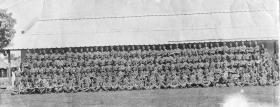
44th Indian Airborne Division
44th Indian Airborne Division
The 44th (Indian) Airborne Division was established at Secunderabad India in April 1945 under Maj Gen EE Down.
During the forming up process it was tasked to conduct an airborne assault on Japanese positions at the mouth of the Rangoon River at Elephant Point. A hastily assembled composite Gurkha Battalion was successfully dropped on 1 May 1945.
By the summer of 1945 the division's expansion from the nucleus of the 50th Parachute Brigade was complete. Its units included:
50th (Indian) Parachute Brigade:
16th (British) Parachute Battalion
1st (Indian) Parachute Battalion (formed from 152 Para Bn)
3rd (Gurkha) Parachue Battalion (formed from 154 Para Bn)
77th (Indian ) Parachute Brigade:
This unit was formed from the 77th Indian Infantry Brigade and established in the summer of 1945 under Brig CJ Wilkinson. It consisted of:
15th (British) Parachute Battalion
4th (Indian) Parachute Battalion (formed from 153 Para Bn)
2nd (Gurkha) Parachute Battalion (formed from 153 Para Bn)
44th (British) Independent Pathfinder Company
14th Air Landing Brigade:
Elements from General Wingate’s Special Force (from the 3rd (Indian) Division) and the 14th Brigade were re-designated as the 14th Air Landing Brigade, which was formed under Brig T Brodie. It consisted of;
2nd Battalion The Black Watch
4th Battalion Rajputana Rifles
6/16th Punjab Regiment
Division Troops:
There were difficulties recruiting divisional troops to man the following division arms and services with British personnel and the requisite skills and experience. They were:
60th Indian Parachute Field Ambulance
159th Parachute Light Regiment RA
23rd Light anti-Aircraft/ Anti-Tank Regiment RA
44th Indian Airborne Division Reconnaissance Squadron
12th Parachute Squadron RE
58th Indian Parachute Composite Platoon RIASC
The division formed shortly before the end of Second World War hostilities. Its primary operational contribution apart from the parachute assault at Elephant Point in May 1945 was to air-drop teams to oversee POW and Internee relief after the Japanese surrender in August.
It was renamed the 2nd Indian Airborne Division towards the end of 1945.
Newsletter Signup
Donate
Make a donation to Airborne Assault ParaData to help preserve the history of The Parachute Regiment and Airborne Forces
The Airborne Shop
The Airborne Shop is the official shop of Support Our Paras (The Parachute Regiment Charity RCN1131977).
Profits from all sales made through our shop go directly to Support Our Paras, so every purchase you make with us will directly benefit The Parachute Regiment and Airborne Forces.

















Latest Comments
There are currently no comments for this content.
Add Comment
In order to add comments you must be registered with ParaData.
If you are currently a ParaData member please login.
If you are not currently a ParaData member but wish to get involved please register.